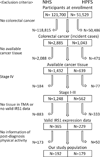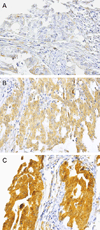Survival Benefit of Exercise Differs by Tumor IRS1 Expression Status in Colorectal Cancer
- PMID: 26577117
- PMCID: PMC4747829
- DOI: 10.1245/s10434-015-4967-4
Survival Benefit of Exercise Differs by Tumor IRS1 Expression Status in Colorectal Cancer
Abstract
Background: High-level physical activity is associated with lower colorectal cancer (CRC) mortality, likely through insulin sensitization. Insulin receptor substrate 1 (IRS1) is a mediator of insulin and insulin-like growth factor (IGF) signaling pathways, and its down-regulation is associated with insulin resistance. Therefore, we hypothesized that tumor IRS1 expression status might modify cellular sensitivity to insulin and IGF, and the prognostic association of physical activity.
Methods: We assessed IRS1 expression level in 371 stage I-III rectal and colon cancers in the Nurses' Health Study and the Health Professionals Follow-up Study by immunohistochemistry. In survival analysis, Cox proportional hazards model was used to assess an interaction between post-diagnosis physical activity (ordinal scale of sex-specific quartiles Q1 to Q4) and IRS1 expression (ordinal scale of negative, low, and high), controlling for potential confounders, including microsatellite instability, CpG island methylator phenotype, long interspersed nucleotide element-1 (LINE-1) methylation level, and KRAS, BRAF, and PIK3CA mutation status.
Results: There was a statistically significant interaction between post-diagnosis physical activity and tumor IRS1 expression in CRC-specific mortality analysis (P interaction = 0.005). Multivariable hazard ratio (95% confidence interval) for higher post-diagnosis physical activity (Q3-Q4 vs. Q1-Q2) was 0.15 (0.02-1.38) in the IRS1-negative group, 0.45 (0.19-1.03) in the IRS1-low group, and 1.32 (0.50-3.53) in the IRS1-high group.
Conclusions: The association of post-diagnosis physical activity with colorectal carcinoma patient survival may differ by tumor IRS1 expression level. If validated, tumor IRS1 expression status may serve as a predictive marker to identify subgroups of patients who might gain greater survival benefit from an increased level of exercise.
Conflict of interest statement
Figures


References
-
- Giovannucci E. Insulin, insulin-like growth factors and colon cancer: a review of the evidence. J Nutr. 2001;131(11 Suppl):3109S–3120S. - PubMed
-
- Giovannucci E. Modifiable risk factors for colon cancer. Gastroenterol Clin North Am. 2002;31(4):925–943. - PubMed
-
- Chang CK, Ulrich CM. Hyperinsulinaemia and hyperglycaemia: possible risk factors of colorectal cancer among diabetic patients. Diabetologia. 2003;46(5):595–607. - PubMed
-
- Komninou D, Ayonote A, Richie JP, Jr, Rigas B. Insulin resistance and its contribution to colon carcinogenesis. Exp Biol Med (Maywood) 2003;228(4):396–405. - PubMed
Publication types
MeSH terms
Substances
Grants and funding
- R35 CA197735/CA/NCI NIH HHS/United States
- R01 CA118553/CA/NCI NIH HHS/United States
- P01 CA087969/CA/NCI NIH HHS/United States
- P01 CA055075/CA/NCI NIH HHS/United States
- R01 CA151993/CA/NCI NIH HHS/United States
- R01 CA137178/CA/NCI NIH HHS/United States
- K24 DK098311/DK/NIDDK NIH HHS/United States
- P01 CA87969/CA/NCI NIH HHS/United States
- UM1 CA186107/CA/NCI NIH HHS/United States
- R01 CA169141/CA/NCI NIH HHS/United States
- P01 CA55075/CA/NCI NIH HHS/United States
- UM1 CA167552/CA/NCI NIH HHS/United States
- P50 CA127003/CA/NCI NIH HHS/United States
- K07 CA190673/CA/NCI NIH HHS/United States
LinkOut - more resources
Full Text Sources
Other Literature Sources
Medical
Research Materials
Miscellaneous

